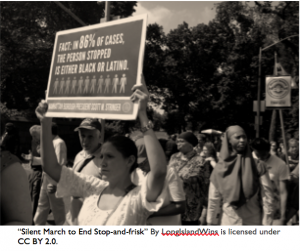Over the last month, we’ve highlighted the ways scholars, activists and journalists work to further social justice around the issue of stop-and-frisk. Today, we bring it all together.
The stop-and-frisk information guide (or Module Packet) is designed to bring together scholarship, activist strategies, and digital media tools to help you create your own stop-and-frisk social justice campaign.
Our goal with bring this all together is to create a practical, resource-rich, all-in-one introduction to start a social justice digital campaign, whether you are an activist on the ground, a journalist writing a story or an academic who may want to connect your research to social change. If you are teaching a class or training people in your organization, you can also use this Information Guide as a tool for teaching and learning about stop-and-frisk.
This Information Guide is structured around three levels of social justice outcomes:
- Make Your Issues Their Interest: Raising Awareness About An Issue with an Audience
- Make Your Issue Their Issue: Getting an Audience More Deeply Engaged in An Issue
- Make Your Issue Their Action: Moving an Audience Towards a Specific Action
Throughout this Information Guide, we cover basic campaigning how-to’s, some of the best tools for collaboration and outreach, and provide examples from the JustPublics@365 stop-and-frisk series.
We hope that the Information Guide will help you reach you more people by integrating some of the most widely used social networks into your social justice campaign, your reporting, and your research or your classroom projects.
If you have any questions in planning your campaign, please feel free to contact us at justpublics365@gmail.com or send us a tweet, @JustPublics365.
Click here to download the Stop-And-Frisk Information Guide [pdf]



